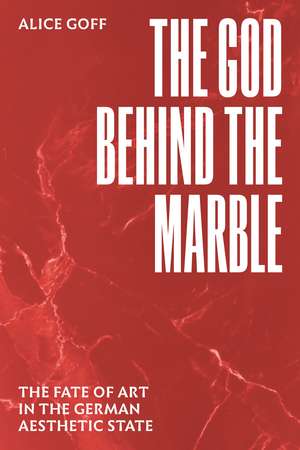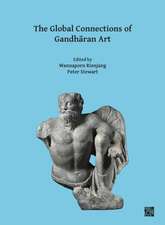The God behind the Marble: The Fate of Art in the German Aesthetic State
Autor Alice Goffen Limba Engleză Hardback – 17 ian 2024
For German philosophers at the turn of the nineteenth century, beautiful works of art acted as beacons of freedom, instruments of progress that could model and stimulate the moral autonomy of their beholders. Amid the Revolutionary and Napoleonic wars, Germans struggled to uphold these ideals as they contended with the destruction of art collections, looting, and questions about cultural property. As artworks fell prey to the violence they were supposed to transcend, some began to wonder how art could deliver liberation if it could also quickly become a spoil of war. Alice Goff considers a variety of works—including forty porphyry columns from the tomb of Charlemagne, the Quadriga from the Brandenburg Gate in Berlin, the Laocoön group from Rome, a medieval bronze reliquary from Goslar, a Last Judgment from Danzig, and the mummified body of an official from the Rhenish hamlet of Sinzig—following the conflicts over the ownership, interpretation, conservation, and exhibition of German collections during the Napoleonic period and its aftermath.
Preț: 305.56 lei
Nou
Puncte Express: 458
Preț estimativ în valută:
58.47€ • 61.21$ • 48.38£
58.47€ • 61.21$ • 48.38£
Carte disponibilă
Livrare economică 15-29 martie
Livrare express 04-08 martie pentru 50.28 lei
Preluare comenzi: 021 569.72.76
Specificații
ISBN-13: 9780226827100
ISBN-10: 0226827100
Pagini: 344
Ilustrații: 9 color plates, 17 halftones
Dimensiuni: 152 x 229 x 28 mm
Greutate: 0.8 kg
Ediția:First Edition
Editura: University of Chicago Press
Colecția University of Chicago Press
ISBN-10: 0226827100
Pagini: 344
Ilustrații: 9 color plates, 17 halftones
Dimensiuni: 152 x 229 x 28 mm
Greutate: 0.8 kg
Ediția:First Edition
Editura: University of Chicago Press
Colecția University of Chicago Press
Notă biografică
Alice Goff is assistant professor of history and the College at the University of Chicago.
Cuprins
List of Illustrations
Introduction
1 To the Vandals They Are Stone
2 A Brilliant Place
3 The State of the Supplicant
4 Uncertain Saints
5 Stepping onto the Pedestal
6 Hegel’s Neighbor
Coda
Acknowledgments
Notes
Selected Bibliography
Index
Introduction
1 To the Vandals They Are Stone
2 A Brilliant Place
3 The State of the Supplicant
4 Uncertain Saints
5 Stepping onto the Pedestal
6 Hegel’s Neighbor
Coda
Acknowledgments
Notes
Selected Bibliography
Index
Recenzii
"For idealists such as Hegel, beauty was meant to transcend politics—so what happened when, as often in the Napoleonic era, works of art became spoils of war? Goff takes up the question with a close study of objects including the Laocoön Group."
“Goff’s engaging book delves into the cultural politics of revolutionary-era France and the German states conquered, then lost, by Napoleon—a pivotal, electric moment in which art and its meanings were up for grabs. An astute reader of images as well as texts, Goff makes a distinctive contribution with her insistence on keeping art, aesthetics, political engagement, and institutional histories firmly intertwined and in conflict.”
“Goff’s fine book is a deeply researched and elegantly written analysis of a significant chapter in the long and complex history of art’s role in German culture and politics.”
“The God behind the Marble provides a treasure chest of famous and little-known scholars, statesmen, and artists in the era of the French Revolutionary and Napoleonic Wars. The French fought, conquered, and grabbed as much art as they could from the cities, courts, and monasteries in the territories they conquered, then transported it back to Paris. The Germans called this the Kunstraub and pushed back. This is a book that takes seriously both the material and the political aspects of art objects. Goff provides a compelling portrait of what is at stake in confiscating art and trying to protect it in its original spaces.”
"This groundbreaking and extraordinarily timely study is an object lesson in what happens if we recognize the dynamic nature of institutions that seem so stable, if we read the historical record for the passions and aspirations of individuals attempting to understand and organize the meaning of art objects. From noble patrons to imperial plunderers, from museum visitors to curators and museum guards, from philosophers to architects: the turn of the nineteenth century saw a number of vital and mutually shaping responses to what art could be. We are still living in the aftermath of an unresolved process that Goff illustrates in a number of richly developed case studies, sensitive at once to historical context, the history of ideas, and the experience of individuals attempting to understand the relationship between material objects, display, and the feelings and ideas those objects and forms of display are based on and shape."















